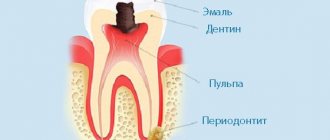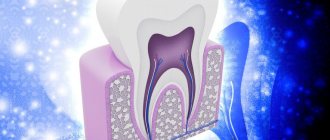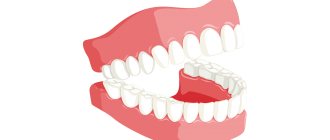During pregnancy, the expectant mother should take care not only of herself, but also of the child, because the health of the child’s teeth can be influenced even before birth.
While waiting for the baby, the expectant mother should eat a balanced diet in order to receive a sufficient amount of vitamins and microelements, and after the birth of the child, breastfeed.
It strengthens the baby's immunity and helps to develop properly. But what to do if, after the appearance of the first teeth, you notice that the enamel on children’s teeth has begun to wear off? The structure of tooth enamel contains calcium hydroxyapatite. Children have a certain supply of calcium from birth, but if it is not enough, the tooth enamel begins to deteriorate.
Tooth wear in children: causes
A child’s teeth wear out for the following reasons:
- congenital abnormal bite;
- bruxism (the child often grinds his teeth in his sleep);
- sensitive and fragile tooth enamel due to certain diseases (hypoplasia, etc.);
- genetic predisposition.
Strong abrasion of tooth enamel is caused by straight and deep bites, leading to accelerated exposure of dentin. One of the reasons for the appearance of malocclusion is disturbances in the development of the jaws, which increases the load on the teeth.
A child’s teeth can also wear out due to systemic diseases that reduce the resistance of body tissues: endocrine disorders, diseases of the central nervous system, etc.
Tooth wear can go through several stages.
Clinical researches
Clinical studies have proven that regular use of professional toothpaste ASEPTA REMINERALIZATION improved the condition of the enamel by 64% and reduced tooth sensitivity by 66% after just 4 weeks.
Sources:
- Features of personal response in the prevention and treatment of hypersensitivity of teeth against the background of type 2 diabetes mellitus A.K. YORDANISHVILI, Doctor of Medical Sciences, Professor, North-Western State Medical University named after. I.I. Mechnikov, Military Medical Academy named after. CM. Kirova, International Academy of Sciences of Ecology, Human Safety and Nature, N.A. UDALTSOVA, Candidate of Medical Sciences, Associate Professor, St. Petersburg State University of the Government of the Russian Federation; dental clinic No. 29, Frunzensky district of St. Petersburg, O.V. PRYSYAZHNYUK, head. surgical department No. 2, dental clinic No. 29, Frunzensky district of St. Petersburg
- Report on the determination/confirmation of the preventive properties of personal oral hygiene products “ASEPTA PLUS” Remineralization doctor-researcher A.A. Leontyev, head Department of Preventive Dentistry, Doctor of Medical Sciences, Professor S.B. Ulitovsky First St. Petersburg State Medical University named after. acad. I.P. Pavlova, Department of Preventive Dentistry
Degrees of tooth abrasion
- Stage I – the enamel of the cutting edges of the child’s incisors and canines and the upper part of the chewing cusps and molars is erased, the dentin is partially affected.
- Stage II – severe abrasion of the chewing tubercles with exposure of dentin tissue.
- Stage III – the height of the tooth crown is reduced to 2/3 of the normal size during wear.
- Stage IV – abrasion of the tooth to the level of the neck. The crown of the tooth is almost completely erased.
If 1 – 2 teeth of a child are worn out, then this is local abrasion; if several teeth or the entire dentition are affected, then this is generalized abrasion.
How to care for teeth enamel after polishing and whitening
The thickness of the protective cover varies from 2 to 2.5 mm. With thinning, increased sensitivity appears. Taking care of your teeth after professional cleaning or polishing will not only prolong the effect, but also allow you to experience less discomfort. During such procedures, the protective layer becomes very thin and, if not properly cared for, its structure may be damaged.
Dentists recommend using toothpastes to reduce tooth sensitivity and regularly using special rinses and dental floss. Immediately after the procedure, it is strictly forbidden to smoke or drink drinks that are too hot or too cold. At night, they may recommend wearing a mouth guard with a special gel. Increased sensitivity in the first days after the procedure is a standard side effect.
Care after teeth whitening includes a “white diet”. It is prohibited to consume foods with high concentrations of coloring substances. This includes wine, coffee, berries, colored vegetables and fruits, soda, spices, and products with a high cocoa content. Sticking to a strict diet is especially important in the first two weeks after whitening.
It is recommended to consume more fish, white meat, egg whites, dairy products and rice. All foods that can damage the thinned surface are excluded from the diet. Strictly monitor the temperature, as changes will negatively affect the appearance and health of the oral cavity. All restrictions are introduced only for the first 14 days after the dental procedure.
Hyperesthesia interferes with the usual way of life. It is painful to eat and drink, and discomfort occurs when the temperature changes. Fluoridation may be needed. The disease must be treated only under the supervision of a specialist. It is important to exclude products that are harmful to enamel and follow hygiene rules.
Pathological abrasion: consequences
Pathological abrasion – rapid reduction of enamel and dentin, teeth become shorter, sensitivity increases. How to understand that tooth wear has become pathological, and what could be the consequences?
- The surface of the child’s teeth becomes distorted and destroyed, and the edges of the tooth enamel become sharp. This can injure the tongue, as well as the delicate mucous membrane of the cheeks and lips.
- The height of the teeth changes (if the disease progresses), which leads to malocclusion and deformation of the lower part of the child’s face.
- The position of the temporomandibular joint may change, and this can injure the jaw.
- The sensitivity of tooth enamel increases.
Indications
There are opposing opinions among dentists regarding the procedure, but there are situations in which filing is necessary:
- When installing crowns. For reliable fixation of the crown, it must fit tightly to the tooth surface.
Since the anatomical shape of each molar or incisor is not ideal, grinding down of the upper layers of their hard tissue is required. This allows you to give your own bone organ the correct geometric shape, thanks to which the manufactured product is firmly fixed and does not stand out among other elements of the jaw row. - For fixing veneers. Ceramic plates fixed to the surface of your own teeth have a certain thickness.
Therefore, in order for the installed microprostheses to fit firmly and not protrude beyond the boundaries of the native units, a small amount of hard tissue is ground off from the vestibular side of the elements of the jaw row. - Preparation for inlays. If it is necessary to mask the cavity formed as a result of carious lesions, ceramic or metal inlays can be used.
Their fixation requires the creation of side walls and the formation of the required depth near the cavity. - In case of installation of an orthodontic structure. Cutting down a small thickness of the top layer of the tooth allows you to make room for correcting the position of the remaining elements of the row without the need to remove them.
In addition, this option is often used in cases of increased crowding of teeth, since it facilitates the placement of fastening elements of the bracket system on them. - If there is damage to the enamel. Chips on the surface of the front incisors can be made less noticeable by slightly filing down the enamel.
This improves the aesthetics of the appearance of the jaw row and eliminates the need for composite restoration. - In case of elongated incisors. If the front teeth are longer than the rest of the row, this can not only cause psychological discomfort, but also interfere with correct diction or complete chewing of food.
To solve the problem, in some cases, filing the length of organs protruding from the common line is used. - At sharp angles. The anatomical structure of the anterior incisors is not always ideal. If there are sharp corners, dentists may recommend filing them down, which will increase the aesthetic appearance of the entire jaw row.
Indications for the use of orthoimplants and tactics for their installation.
Let's discuss here how the braces system works.
At this address https://orto-info.ru/ortodonticheskoe-lechenie/podgotovitelnyiy-period/separatsiya-zubov.html we will talk about abrasive teeth separation.
What to do if your child's teeth are worn out
Treatment for tooth wear is developed individually. At the appointment, the pediatric dentist analyzes the causes of the pathology, determines the stage of erasure, the nature of the disease and the characteristics of the development of the child’s body.
Technique
The procedure for filing teeth is carried out in several stages:
- Preparation. At the first meeting, the dentist assesses the condition of the patient’s jawbone elements, determines whether there is a need for cutting down hard tissue and whether there are contraindications to the procedure.
- Identifying problem areas. Using carbon paper, a liquid aerosol or a wax plate, the dentist determines the overestimated areas of the tooth. Areas that require sanding will be colored more intensely.
- Sawing. The filing procedure may vary slightly depending on the goal to be achieved and the shape of the tooth being processed.
So, when treating chewing molars, the dentist carefully grinds off the top layer of enamel from the surface of the tubercles. When cutting down the front incisors, multidirectional movements are carried out.
In some cases, it may be necessary to preliminary make a diagnostic model based on casts of the patient’s jaw rows.
The resulting gypsum sample is subjected to careful inspection and evaluation filing. Carborundum cutters or diamond burs are used as instruments for the operation
The procedure often ends with polishing and remineralization of the treated units. The dentist applies a certain composition containing a complex of useful substances to the enamel to increase the strength of the outer layer of the tooth and reduce permeability .
Methods for restoring tooth enamel
A small defect in tooth enamel can be successfully eliminated using remineralization. Weak spots are filled with products that contain a lot of fluoride and calcium. They protect dental plates by forming a barrier between the outer shell and aggressive factors. For greater effect, mouth guards are used that allow the active components to remain on the weakened area for the required amount of time.
Dental enamel implantation is an innovative method that eliminates the abrasion of the protective layer. At the cellular level, the enamel prism and implant material are fused, resulting in the restoration of the natural structure of tooth enamel.
Thin dental ceramic onlays are also popular. Veneers and lumineers are very convenient for reducing the thickness of the enamel layer on the front incisors. The essence of this correction method is to remove a small amount of the patient’s enamel layer and fix the veneer on the outer surface. When using lumineers, you do not need to remove anything.
Modern regeneration methods will help restore both simply thinned and severely damaged enamel layers.











